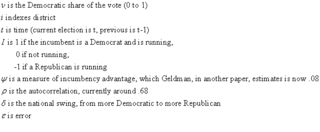This will be cross posted to Swingstatesproject.
It’s based on an article by Kastellec, Gelman and Chandler entitled “Predicting and dissecting the seats-votes curvein the 2006 US House Election” which is forthcoming, and which I found through Gelman’s blog (the blog has lots of cool things for geeks).
Andrew was nice enough to give his permission.
If I mess up his argument, I apologize.
How well did the Democrats do in 2006? Very well indeed. Everyone acknowledges that. But how well? As well as the Republicans in 1994?
In 2006, the Democrats gained 31 seats to take control of the House. In 1994 the Republicans gained 54 seats. So, at first glance, it seems like the 2006 election, big as it was, wasn’t quite as big as 1994. But Kastellec, Gelman and Chandler (henceforth KGC) show that this is incorrect, and the Democratic victory was even bigger than 1994.
There are two general ways of predicting the House: Nationally or district by district. National forecasts are typically based on such variables as the economy, views of the president, and so on. They can be useful, but district-by-district methods let us account for local condition. KGC use two local conditions to help predict races; despite this parsimony, the model is quite useful. Their two conditions are the election results in the previous election, and whether the incumbent is running again. They then model,using simulation, how these would be affected by a variety of national tendencies towards voting Republican or Democratic. Then, these various estimates, and the resultant change in seats, can be graphed. (See the paper).
For those who like formal models:

where

They let the swing range from R +10 to D +10, and simulate each condition 1000 times.
Based on all this (and more, see the paper) they estimate that the Democrats needed 52% of the average district vote to have a 50% chance of winning control of the House. Why?
Two reasons: 1) Geography and gerrymandering, and 2) incumbency
In the first, the Democrats waste more of their votes. There are far more Democratic districts than Republican districts that are won by huge margins. Part of this is due to geography, but it’s enhanced by gerrymandering (more on this in another diary). Incumbency is an advantage because people tend to vote for the incumbent.
Where does this leave us for 2008? Well, geography and gerrymandering haven’t changed, but incumbency certainly has. Not only are there now more Democratic than Republican incumbents, but more of the Democrats are running, especially in closer districts (see my diary more signs of Democratic gains to come. That’s one of the problems with gerrymandering: When the mood shifts, or your gerrymandered representative retires or dies, there is more of a chance for a switch.
KGC estimates that if the Democrats get 49% of the average district vote, they will maintain control of the House. If the Democrats get 55% of the average district vote, they should get about 58% of the seats, which would be a gain of 8 seats.
In a later diary, I’ll use the CGK formula on each district
Then there’s the national mood, which I’m willing to bet favors Democrats.


